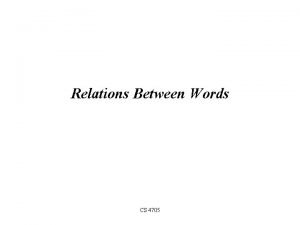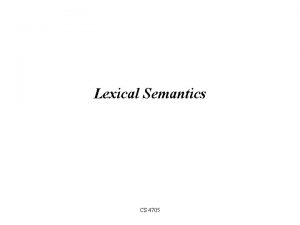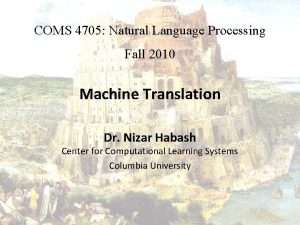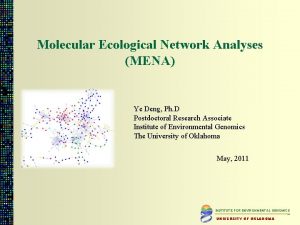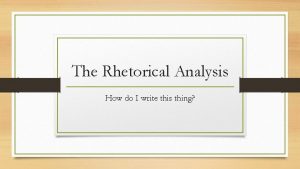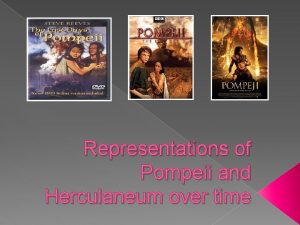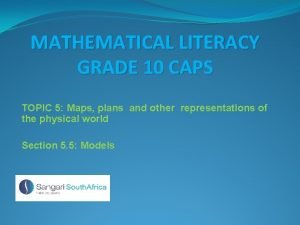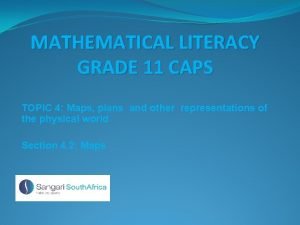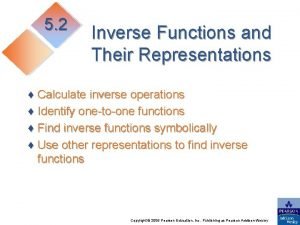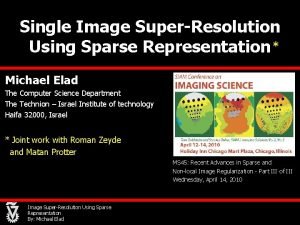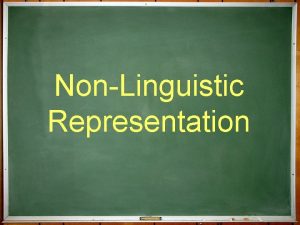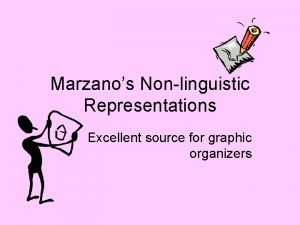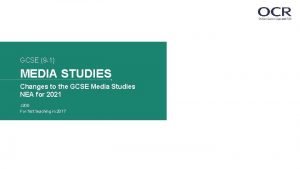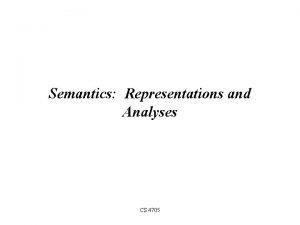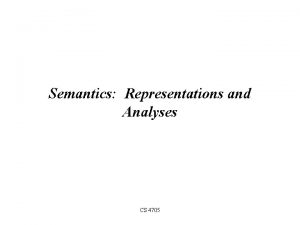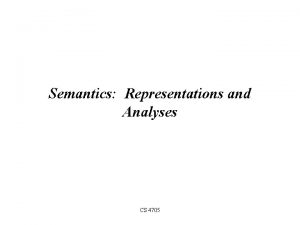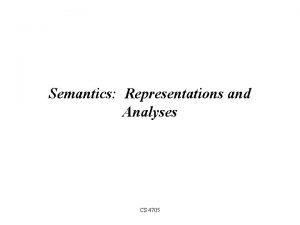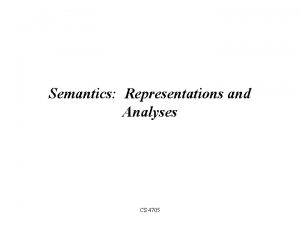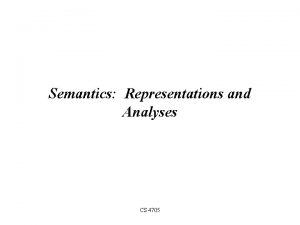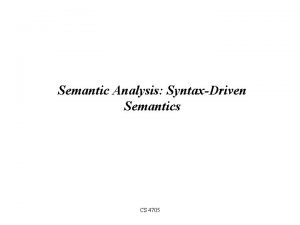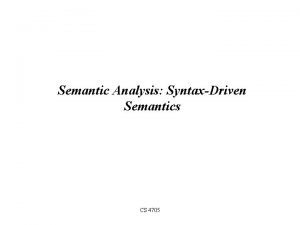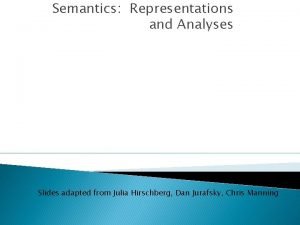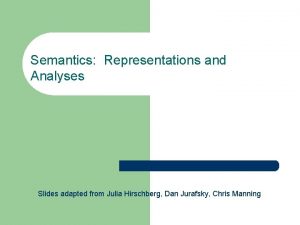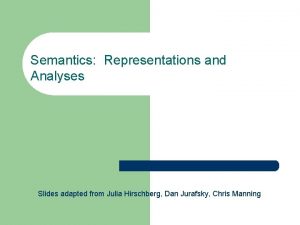Semantics Representations and Analyses CS 4705 What kinds


















- Slides: 18

Semantics: Representations and Analyses CS 4705

What kinds of meaning do we want to capture? • Categories/entities – IBM, Jane, a black cat, Pres. Bush • Events – running a mile, AS elected governor of CA • Time – Oct 30, next week, in 2 years • Aspect – Jack knows how to run. Jack is running. Jack ran the mile in 5 min. • Beliefs, Desires and Intentions (BDI)

What Can Serve as a Meaning Representation? • Anything that allows us to – Answer questions (What is the tallest building in the world? ) – Determine truth (Is the blue block on the red block? ) – Draw inferences (If the blue block is on the red block and the red block is on the tallest building in the world, then the blue block is on the tallest building in the world)

Meaning Representations • All represent ‘linguistic meaning’ of I have a car and state of affairs in some world • All consist of structures, composed of symbols representing objects and relations among them – FOPC: – Semantic Net: having haver speaker had-thing car

• Conceptual Dependency Diagram: Car Poss-By Speaker • Frame Having Haver: S Had. Thing: Car

A Standard Representation: Predicate. Argument Structure • Represents concepts and relationships among them – Nouns as concepts or arguments (red(ball)) – Adjectives, adverbs, verbs as predicates (red(ball)) • Subcategorization (or, argument) frames specify number, position, and syntactic category of arguments – NP likes NP – NP likes Inf-VP – NP likes NP Inf-VP

Semantic (Thematic) Roles • Subcat frames link arguments in surface structure with their semantic roles – Agent: George hit Bill was hit by George. – Patient: George hit Bill was hit by George. • Selectional Restrictions: constraints on the types of arguments verbs take George assassinated the senator. *The spider assassinated the fly. assassinate: intentional (political? ) killing

First Order Predicate Calculus • Not ideal as a meaning representation and doesn't do everything we want -- but better than many… – – Supports the determination of truth Supports compositionality of meaning Supports question-answering (via variables) Supports inference

NL Mapping to FOPC • Terms: constants, functions, variables – Constants: objects in the world, e. g. Huey – Functions: concepts, e. g. sisterof(Huey) – Variables: x, e. g. sisterof(x) • Predicates: symbols that refer to relations that hold among objects in some domain or properties that hold of some object in a domain likes(Huey, kibble) cat(Huey)

• Logical connectives permit compositionality of meaning kibble(x) likes(Huey, x) “Huey likes kibble” cat(Vera) ^ odd(Vera) “Vera is an odd cat” sleeping(Huey) v eating(Huey) “Huey either is sleeping or eating” • Sentences in FOPC can be assigned truth values – Atomic formulae are T or F based on their presence or absence in a DB (Closed World Assumption? ) – Composed meanings are inferred from DB and meaning of logical connectives

– cat(Huey) – sibling(Huey, Vera) – cat(Huey) ^ sibling(Huey, Vera) cat(Vera) • Limitations: – Do ‘and’ and ‘or’ in natural language really mean ‘^’ and ‘v’? Mary got married and had a baby. And then… Your money or your life! – Does ‘ ’ mean ‘if’? If you go, I’ll meet you there. – How do we represent other connectives? She was happy but ignorant.

• Quantifiers: – Existential quantification: There is a unicorn in my garden. Some unicorn is in my garden. – Universal quantification: The unicorn is a mythical beast. Unicorns are mythical beasts. – Many? A few? Several? A couple?

Temporal Representations • How do we represent time and temporal relationships between events? It seems only yesterday that Martha Stewart was in prison but now she has a popular TV show. There is no justice. • Where do we get temporal information? – Verb tense – Temporal expressions – Sequence of presentation • Linear representations: Reichenbach ‘ 47

– Utterance time (U): when the utterance occurs – Reference time (R): the temporal point-of-view of the utterance – Event time (E): when events described in the utterance occur George is eating a sandwich. -- E, R, U George had eaten a sandwich (when he realized…) E–R–U George will eat a sandwich. --U, R – E While George was eating a sandwich, his mother arrived.

Verbs and Event Types: Aspect • Statives: states or properties of objects at a particular point in time I am hungry. • Activities: events with no clear endpoint I am eating. • Accomplishments: events with durations and endpoints that result in some change of state I ate dinner. • Achievements: events that change state but have no particular duration – they occur in an instant I got the bill.

Beliefs, Desires and Intentions • Very hard to represent internal speaker states like believing, knowing, wanting, assuming, imagining – Not well modeled by a simple DB lookup approach so. . – Truth in the world vs. truth in some possible world George imagined that he could dance. George believed that he could dance. • Augment FOPC with special modal operators that take logical formulae as arguments, e. g. believe, know

Believes(George, dance(George)) Knows(Bill, Believes(George, dance(George))) • Mutual belief: I believe you believe I believe…. – Practical importance: modeling belief in dialogue – Clark’s grounding

Sum • Many hard problems in full semantic representation: – Temporal relations: tense, aspect – BDI • Current representations impoverished in many respects • Next time: Read Ch 15: 1 -4, 6
 Compare procedural semantics and declarative semantics.
Compare procedural semantics and declarative semantics. 4705 in word
4705 in word Today meaning
Today meaning Coms 4705
Coms 4705 Importance of critical thinking in nursing process
Importance of critical thinking in nursing process Concln
Concln Rhetorical choice
Rhetorical choice Icp courtage
Icp courtage A day in pompeii vimeo
A day in pompeii vimeo Cultural representations and signifying practices
Cultural representations and signifying practices Floor plans maths lit
Floor plans maths lit Types of maps in maths lit
Types of maps in maths lit Maps, plans and other representations of the physical world
Maps, plans and other representations of the physical world Mathematical literacy grade 11 maps and plans
Mathematical literacy grade 11 maps and plans Functions and their representations
Functions and their representations On single image scale-up using sparse-representations
On single image scale-up using sparse-representations Nonlinguistic representations
Nonlinguistic representations Nonlinguistic representation examples
Nonlinguistic representation examples Unit 1: media representations mark scheme
Unit 1: media representations mark scheme

